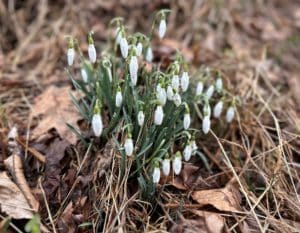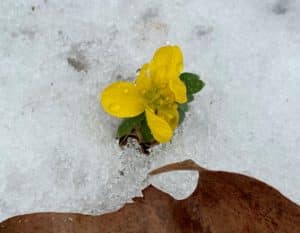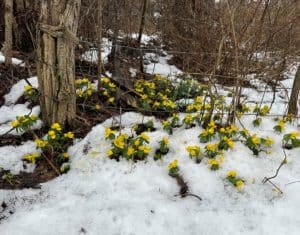Hello fellow readers, Snowdrops and Winter Aconite are in bloom leading me to the folklore of the winter flowers. And how Snowdrops, known as Candlemas Bells, are featured on Candlemas Day, representing hope.
You likely know the most famous legend for March – In like a lion, out like a lamb. (There are many others in March Folklore of Hope you’ll enjoy). It wasn’t until the last day of February that we had our first measurable snow, making me wonder if there is weather folklore for February, and there is.

Jolee is enjoying a jaunt next to the Stacked Stones “art” Curt created. Link to the Etiquette of Pilfering Stones
The Old Farmer’s Almanac lists: “There is always one fine week in February. If bees get out in February, the next day will be windy and rainy. Winter’s back breaks about the middle of February. And fogs in February mean frosts in May.”We had a lot of fog in February with the warm temperatures by day and the frosty nights. So will there be many heavy frosts in May? Uh oh!

Snowdrops, known as Candlemas Bells, are featured on Candlemas Day, representing hope.
Candlemas Bells Represent Hope
Snowdrops emerged early in our neck of the woods. Typically, we see them in the middle of March. But as it turns out, snowdrops appear earlier elsewhere and are the flower of a Christian Holiday on February 2nd. Candlemas celebrates the first bringing of baby Jesus to the Temple of Jerusalem to welcome him into Judaism. It also marks the Virgin Mary’s purification.
Snowdrops (Galanthus), those lovely little nodding white flowers that magically emerge through the last layer of winter’s frosting, are also known as Candlemas Bells, representing Jesus bringing hope to the world. Traditions of blessing candles symbolizing Jesus Christ being the Light of the World continue, especially among Roman Catholic, Orthodox, Methodist, Episcopalian, and Lutheran religions.
There’s a legend that after Adam and Eve ate the forbidden fruit and God banished them from the Garden of Eden, which was no more. They became mortal, living the hardships of life, sickness, pain, shortages of food, and even death. When Eve grew weary of endless winters, an angel fashioned snowdrops to assure her winter didn’t last forever, symbolizing hope as the first flowers to appear.
Whenever I see their lovely little faces, I am reminded to put some in the yard. I’ve often wondered how the ones along the road arrived there. Perhaps someone planted them, though it seems unlikely. Maybe birds moved the bulbs. Or maybe angels seeded them there.

Winter Aconite brings sunshine to the snow.
More Winter Bloomers

Winter Aconite (Eranthis hyemalis) is in the buttercup family.
Another early bloomer next to the sheep farm on Cobblewood Road showed her sunny yellow flower buds – Winter Aconite (Eranthis hyemalis) in the buttercup family. Each cup-shaped flower is encased by bright green bracts resembling a collar. They go dormant in summer, and the foliage dies back. And they can get weedy and aren’t ideal if you have small children or pets, as they are poisonous. The same is true of snowdrops.
Beyond the early bloomers, the sheep gave birth early. Most recently, I came upon two little white lambs next to their mama, making me think of the iconic poem. Mary had a Little Lamb often was recited to me as a child. And one of the first songs I played on the piano when given the gift of lessons from who became my dear “Mom J” (Jackson) later in life.

Mary had a Little Lamb.
The poem, first published in 1830, teaches a lesson of acceptance, kindness, and love. Did you know it’s based on a real story of a lamb that followed Mary Elizabeth Sawyer, a woman born in 1806 on a farm in Sterling, Massachusetts? It seems the momma sheep shunned the lamb, so Mary adopted it as her pet.
I wondered how the little beauties, the Snowdrops, and Winter Aconite would fare under the heavy blanket of snow. They emerged unscathed. Mother Nature knows what she is doing. Our goal is to trust and allow. To let go of forcing things. It’s all part of the rhythm of nature, and it is perfect. And so are you.
Garden Dilemmas? AskMaryStone@gmail.com (and your favorite Podcast App).
There’s much more to the story in the Garden Dilemmas Podcast:
Links to related stories you’ll enjoy:
Planting Snowdrops & Spring Bulbs
The Old Farmer’s Almanac Weather Lore Calendar


